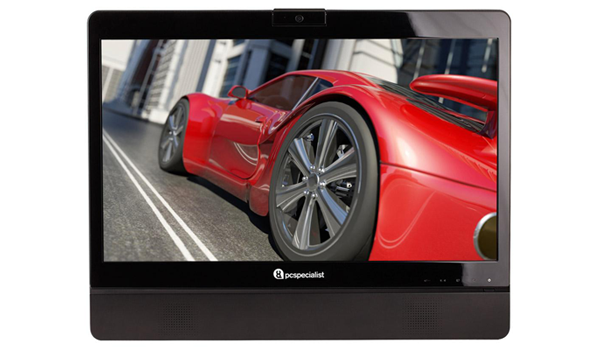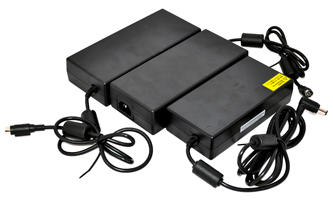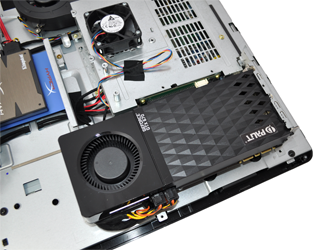Better than a tower?
Display, sound and practicality
PC Specialist's specification tells us that the PowerGlide Extreme's going to be fast - and we'll confirm that with all the usual benchmarks - but in order to live up to its billing as a cover-all-bases all-in-one solution, each component needs to impress.
When it comes to an all-in-one, there's arguably nothing more important than the system's display; it's the part that dictates the user experience, and it's the one component you can't change further down the line.
In the PowerGlide Extreme, we get a 24in BenQ infrared touchscreen (model L241ISG) that supports two-point multi-touch input. Using infrared technology ensures that any touch input can be detected - be it from finger, pen or stylus - and the display's full-HD, 1,920x1,080 resolution provides good on-screen real estate.

The LED display is plenty bright (it's officially rated at 250 nits) and colours appear realistic, but vertical viewing angles could be better. Horizontal viewing angles are good - so there's no problem sharing content with the person next to you - but you do need to be sat in front of the machine to get the best view; sit too low or stand up and contrast is lost. Our biggest criticism, however, would be the display's glossy finish; it makes for vivid colour reproduction, but it also means you'll spend a lot of time looking at your own reflection unless you crank brightness up to maximum using the touch-sensitive controls.
And there is another bone of contention, as well. The touchscreen works well enough - you touch, it responds - but in our time with the machine we never once felt a desire to reach out and use it. Windows 8's touch-orientated interface may change that, but with Windows 7 the touchscreen feels entirely surplus to requirements, and we see little need for such interactivity on what's primarily a gaming machine. Given the choice, we'd gladly lose the touch capability in favour of shaving a few pounds off the system's asking price.
What is handy is that the monitor can also be used as a standalone display, so you can plug in a games console or external device via HDMI and make use of the 24in screen without having to turn on the PC. The display is on the whole highly enjoyable and it's good to know it'll smoothly render the latest games in high-definition, but don't expect much from the integrated 5W stereo speakers. They're useful for standard system alerts and they provide decent volume, but music and games sound flat with little-to-no bass to speak of, and gamers will almost certainly want to invest in an external solution, or a headset.
There's room for improvement, then, and the PowerGlide Extreme doesn't provide the sense of refinement available from other all-in-ones. The exterior aesthetics are best described as black and blocky, and the thickness of the machine prevents it from looking elegant. It's no iMac in the aesthetics department, which is to be expected considering the meaty internal components, but the specification introduces a few pros and cons, too.
We appreciate the fact that a 2.5in hot-swap bay is easily accessible at the top of the machine, but inserted drives jut out and look unsightly, and there's no eject button so yanking the drive from its socket is a challenge.
There's also a sticking point when it comes to cabling. One of the advantages to most all-in-one systems is that they run off a single power cable, and therefore keep cable clutter down to a minimum. The PowerGlide Extreme, when configured with a high-end graphics card such as the GeForce GTX 670, requires three rather-large 180W power bricks; two to feed the graphics card, and the third to provide juice to the rest of the system. As a consequence, this particular all-in-one doesn't do a great job of minimising cable clutter and it occupies three power sockets. The things we do to play games, eh?
A look inside
If you're in the market for a compact, tidy all-in-one PC that's gorgeous on the outside and modest on the inside, you'll be better served by an Apple iMac, a Dell Inspiron or a HP Omni. The real reasons to consider PC Specialist's PowerGlide Extreme are the powerful specification and the promise of easy upgrades.
You see, unlike many all-in-ones, the PowerGlide Extreme's chassis - made by Gigabyte - opens up with ease to allow the user almost-unrestricted access to all the system's vital components.
Removing half-a-dozen screws is all that's needed to detach the back panel and we then get a good look at the internal layout. What we find is that the CPU, GPU and storage devices are easily serviced and user-replaceable - it takes a minute or so to undo the metal shrouds that encase the key components - but there are a few limitations. There's only one internal 2.5/3.5in drive mount, so adding a second internal storage device won't be easy (it'll require some modding, or you could remove the optical drive), and the Kingston HyperX 3K SSD in our test sample isn't optimally configured, either. Turns out the underlying Gigabyte MSH61QI motherboard is limited to SATA 3Gbps, so while the SSD will still be nippy, it won't be able to reach its full SATA 6Gbps potential.
Taking away a few of the internal covers reveals a GeForce GTX 670 from Palit (hooked-up via a right-angled PCIe riser card, no loop-back cable required), two SODIMM memory modules, and an elaborate CPU cooler that consists of three copper heatpipes routed to a flattened heatsink and fan. We'll find out how effective the cooling is a little later in the review, but let's start with some performance benchmarks.














